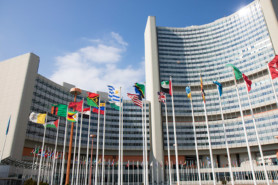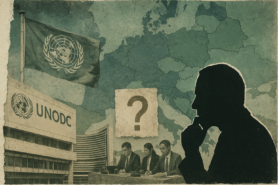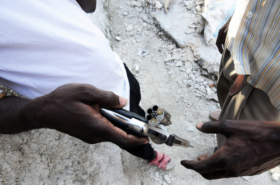Posted on 26 Feb 2019
The latest edition of the UNODC’s Global Report on Trafficking in Persons is arguably more telling in what it omits than what it includes.
The UN Office on Drugs and Crime (UNODC) recently released its Global Report on Trafficking in Persons 2018. This issue – the report has been produced in various forms every two years since 2009, and officially mandated by the General Assembly since 2012 – includes a section on human trafficking in contexts of armed conflict, drawing on findings from interviews with UN personnel working in peacekeeping operations and missions in conflict zones.
The report plays a vital role in helping member states hone their responses to human trafficking. It also aims to play a crucial part in shaping the discourse around and direction of global anti-trafficking efforts, so it is curious that there appear to be certain things that are missing in its message.
Ambiguity in findings
Based on data collected from 142 countries, the report finds, globally, that ‘countries are detecting and reporting more victims, and are convicting more traffickers’. Specifically, ‘more victims of trafficking in persons were reported to UNODC in 2016 than at any time over the past 13 years’, with a peak of 24 000 detected victims in 2016. This does not necessarily equate to an increase in the number of trafficked persons, however – countries’ techniques for detecting and identifying victims have improved over time, while increased attention from the international community may have led to more reporting and data collection generally.
One of the main aims of the report is to provide an overview of trafficking patterns and trends, information about the profiles of victims and offenders, as well as forms of exploitation, detection and conviction. However, here, there are notable inconsistencies and fluctuations in the numbers relating to detected victims, offenders and countries used in the profile analyses for the same year. For example, puzzlingly, the 2016 estimates of victims shifts from 26 750 in 110 countries (under the victim profiles) to 10 772 in 54 countries (under the analysis of exploitation forms), thus making it difficult for the readers to grasp the full picture.
Secondly, the analysis of victims considers variables such as their profile (age group and sex) and forms of exploitation, yet only gender and nationality are presented for offenders. There is no information provided about types of trafficking for which offenders were convicted, prosecuted or investigated. It could be that this missing information is attributable to lack of data submitted by member states. However, an understanding of which trafficking types have been successfully – or otherwise – prosecuted is vital in enhancing states’ capacity and legal measures, and generally in moving the international anti-trafficking efforts forward.
Human trafficking in armed conflict – Where is the elephant in the room?
This Global Report, in addition to its traditional biannual analysis of trafficking trends and patterns, has a special focus on human trafficking in conflict zones. In December 2016 and November 2017, the UN Security Council (UNSC) adopted Resolutions 2331 and 2388. These request that the Secretary-General ‘takes steps to improve the collection of data, monitoring and analysis of trafficking in persons in the context of armed conflict, in order to better identify and prevent its incidence’, as well as expressing concern that TiP in conflict zones continues to occur.
These resolutions, coupled with the increased attention given to trafficking in conflict zones (partly as a result of the activities of Islamic State and Boko Haram), lie behind the motivation for this focus. Human trafficking in conflict contexts has been extensively covered by various stakeholders, such as NGOs, academia, states and intergovernmental organizations (e.g. the Institute for Security & Development Policy 2010, Caritas 2015, United Nations University 2016, the Freedom Fund 2016, US Department of State 2016).
The UNODC itself has also contributed to the issue’s continuing contextualization. For example, the recent report classifies perpetrators into two categories: armed groups and opportunists. What is surprising, then, is the absence in this report of any discussion of the UN’s role in, and hence its liability for, its own international peacekeepers’ sexual abuse in conflict and post-conflict zones, even though there is ample evidence of such transgressions having been committed by UN personnel, and the issue has been covered widely in the media and by NGOs (see, for example, Human Rights Watch, Human Rights Review, Neudorfer, The Washington Post, Redress, International Peace Institute).
Acts of sexual exploitation and abuse by UN peacekeepers compound and overlay the existing humanitarian problem of human trafficking in conflict zones. From a victim’s perspective, being exploited and abused by the very people who are supposed to support and protect can cause long-lasting trauma and distress, both physical and psychological; and from the perspective of a peacekeeping mission, crimes caused by its ‘peacekeepers’ can facilitate and embed the influence of local criminal activities and networks, destabilizing the community and undermining the mission.
One of the first and most widely reported incidents of UN peacekeepers’ involvement in a human-trafficking crisis was during the Balkans conflict, specifically Bosnia and Herzegovina, and Kosovo, where the presence of the Blue Helmets in 1992 ‘sparked an unprecedented increase’ in the trafficking of women and girls, and helped establish a network of brothels and human trafficking that had not existed earlier. The influx of about 60 000 male staff and soldiers in the region, coupled with their substantial purchasing power, boosted sex work and criminal networks.
Investigators found that soldiers were clients in brothels where ‘women sold into forced prostitution’ worked. These criminal networks, initially formed by trafficking in women and girls, later engaged in other criminal activities, including trafficking in narcotics and arms.
Additionally, UN peacekeepers have reportedly raped local women and girls, or exchanged food or money (in some cases, as little as two eggs or US$4) for sexual exploitation of girls as young as 12 and 14 in the Central African Republic (CAR) and the Democratic Republic of the Congo. Disturbingly, victims all too often receive little assistance or justice: UN peacekeepers in CAR ‘have been formally accused of sexually abusing or exploiting 42 local civilians, most of them underage girls. Only one criminal charge has been filed.’
The UN has been widely criticized for its fragmented and dysfunctional response in handling and prosecuting such cases. In CAR, to cite one example, when a 14-year-old girl was assaulted and impregnated by a Burundian soldier, the UN recorded her case as ‘transactional’ sex, as opposed to rape or sexual exploitation, leaving her with no assistance and a baby to raise on almost nothing.
Furthermore, the fact that the UN has little control and command over its peacekeepers, and that the Blue Helmets’ legal status and liability fall in their home countries’ jurisdiction, and not those of the UN, diminish the victims’ already slim likelihood of receiving support and justice. Impunity for peacekeepers who have committed such crimes thus remains a problem – one that is arguably exacerbated by the UN’s lack of incentive to hold its member states accountable, and its need for peacekeeping troops.
Peacekeepers are unfortunately too often part of the problem in contexts of human trafficking in conflict zones. That this issue is absent from the UNODC’s 2018 Global Report should therefore be addressed, especially given that expert interviews with peacekeeping mission officials were conducted for the report, none of whom mention such crimes. The only recommendation, contributed by the UN Police Division, is to review ‘pre-deployment training curricula for field mission personnel to better address trafficking in persons’. Meanwhile, the report is silent on vetting of UN peacekeepers before deployment, and training them on the UN’s zero-tolerance policy on sexual exploitation and abuse.
Moving forward: Better reporting
The UNODC global reports on human trafficking play an important role in the
anti-trafficking narrative, as well as in guiding member states’ responses.
Encouragingly, there have been significant improvements in these reports over
the time, from the first global report in 2009, in which there was no official record of trafficking victims and offenders’ profiles to the current 2018 Global Report, which was produced from the information of about 26 000 detected victims, from about 100 countries.
This analysis therefore hopes to contribute to the ongoing improvement of the reports, specifically with recommendations for a more consistent and detailed analysis of the data, especially concerning numbers of victims and offenders, as well as details about the types of trafficking for which convictions were made.
But, most importantly, it is essential that the Global Report on Trafficking in Persons openly addresses the issue of UN peacekeepers’ sexual abuse and violations – if their international presence in conflict areas is not to continue being ‘part of the problem’.



